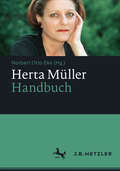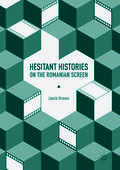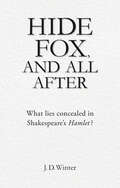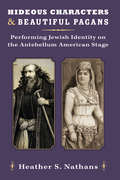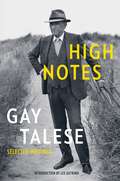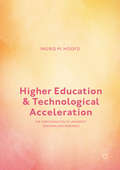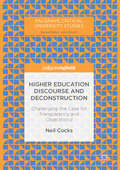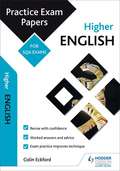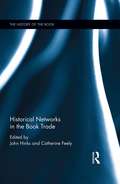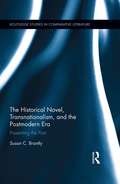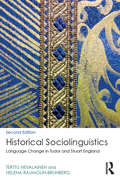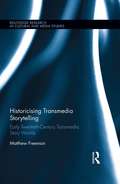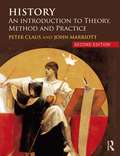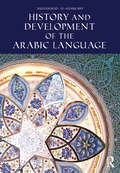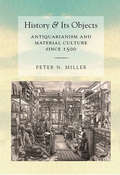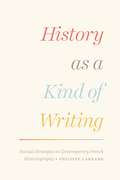- Table View
- List View
Herta Müller-Handbuch
by Norbert Otto EkeDas Handbuch gibt einen umfassenden Überblick über das Werk Herta Müllers in seiner ganzen thematischen Breite und Vielfalt der Genres. Es richtet das Augenmerk dabei insbesondere auf ästhetische Formgebungsverfahren und poetologische Schreibkonzepte und stellt auch die unterschiedlichen Ausdrucksweisen der gesellschaftspolitischen Interventionen der streitbaren Autorin zur Diskussion. Umfangreiche Werkanalysen und Beiträge zur Rezeption und Wirkung von Müllers Werk stehen ebenfalls im Zentrum. Bibliographien und Register runden das Handbuch ab, das fortgeschrittenen Studierenden wissenschaftliche Zugänge zum jeweiligen Thema erschließen soll, zum anderen aber auch Spezialisten in der deutschsprachigen Forschungslandschaft als Anlaufstelle und Orientierung dienen kann.
Hesitant Histories on the Romanian Screen
by László StrauszThis book argues that hesitation as an artistic and spectatorial strategy connects various screen media texts produced in post-war Romania. The chapters draw a historical connection between films made during the state socialist decades, televised broadcasts of the 1989 Romanian revolution, and films of the new Romanian cinema. The book explores how the critical attitude of new Romanian cinema demonstrates a refusal to accept limiting, binary discourses rooted in Cold War narratives. Strausz argues that hesitation becomes an attempt to overcome restrictive populist narratives of the past and present day. By employing a performative and mobile position, audiences are encouraged to consider conflicting approaches to history and social transformation.
Hesitant Histories on the Romanian Screen
by László StrauszThis book argues that hesitation as an artistic and spectatorial strategy connects various screen media texts produced in post-war Romania. The chapters draw a historical connection between films made during the state socialist decades, televised broadcasts of the 1989 Romanian revolution, and films of the new Romanian cinema. The book explores how the critical attitude of new Romanian cinema demonstrates a refusal to accept limiting, binary discourses rooted in Cold War narratives. Strausz argues that hesitation becomes an attempt to overcome restrictive populist narratives of the past and present day. By employing a performative and mobile position, audiences are encouraged to consider conflicting approaches to history and social transformation.
Hide Fox, and All After: What Lies Concealed in Shakespeare's Hamlet?
by J. D. WinterIs there anything more to say on Hamlet? 'Hide fox, and all after,' a casual quip of the Prince, as he and his enemy the King start to hunt each other down, is taken as the title for this closely-considered survey of the play. J D Winter finds question after question in it raised and unanswered, as if the play's dramatic method were in part to create uncertainty in its audience and so draw them in. He adopts three phrases from the text to provide a context for his approach: the play's the thing, a rhapsody of words, and the invisible event. The first phrase suggests the spectacle itself, without regard to what has been written about it. There is no reference to outside opinion nor is another literary work named. The second indicates an awareness of the text as poem. While the tremendous sweep of Shakespearean blank verse, the prose-paragraphs on fire with their own poetry, the whispering gallery of metaphor, can scarcely be accorded proper respect in a prose commentary, certain rhapsodic effects are everywhere noted. Finally, the play is contained within a mystery. So much seems to happen; so little seems to happen. Almost all the major characters are subject to a pattern of error in their dealings as they are swept on from one catastrophic misjudgement to another. The level to which the play is focussed upon the blind time between events is unusually high. This too draws in the audience; it is a part of the spectators own internal experience. There can be no definitive answer to Hamlet or Hamlet. But like a signpost in a swarming mist, the third phrase may offer a faint clue: the invisible event.
Hideous Characters and Beautiful Pagans: Performing Jewish Identity on the Antebellum American Stage
by Heather S NathansWhile battling negative stereotypes, American Jews carved out new roles for themselves within the first theatrical entertainments in America. Jewish citizens were active as performers, playwrights, critics, managers, and theatrical shareholders, and often tied their involvement in these endeavors to the patriotic rhetoric of the young republic as they struggled to establish themselves in the new nation. Examining play texts, theatrical reviews, political discourse, and public performances of Jewish rights and rituals, Hideous Characters and Beautiful Pagans argues that Jewish stage types shed light on our understanding of the status of Jewish Americans during a critical historical period. Using an eclectic range of sources including theatrical reviews, diaries, letters, cartoons, portraiture, tax records, rumors flying around the tavern, and more, Heather S. Nathans has listened for the echoes of vanished audiences who witnessed and responded to these stereotypes onstage, from the earliest appearance of Shylock on an American stage in 1752 to Jewish theater artists on the eve of the Civil War. The book integrates social, political, and cultural histories, with an examination of those texts (both dramatic and literary) that shaped the stage Jew.
High Notes: Selected Writings of Gay Talese
by Gay TaleseA superb new collection from the illustrious career of Gay Talese, "the most important nonfiction writer of his generation" (David Halberstam). Admired by generations of reporters, Gay Talese has for more than six decades enriched American journalism with an unmatched ability to inhabit the worlds of his subjects. From the long-form Esquire articles that germinated into his masterful books--including Honor Thy Father and Thy Neighbor's Wife--to indelible portraits like the canonical "Frank Sinatra Has a Cold" and the recent, revealing account of avant-pop star Lady Gaga's studio session with the old-school crooner Tony Bennett, the pieces collected in High Notes are classics of the journalistic style Talese pioneered--"the art of hanging out," as he called it--and a bold testament to his enduring talent for unparalleled cultural observation and impeccable literary craftsmanship.
Higher Education and Technological Acceleration: The Disintegration of University Teaching and Research
by Ingrid M. HoofdThis book critically examines the relationship between new media technologies, research ethics, and pedagogical strategies within the contemporary university. It debates whether recent transformations of higher education, rather than an effect of neo-liberalization, are actually an outflow of the technological acceleration of the university's own contradictory ideals around knowledge and democracy. The book sets up this argument by likening the university to a "vision machine" which quest for total scientific and social transparency has recently caved in on itself, negatively affecting staff and student well-being. The book asserts that this situation reveals the essential tension at the heart of the university system, and explores the acceleration of this tension by analyzing a variety of teaching and research advances from Europe and Asia. Examining among other issues the call for creativity and critical thinking in the curriculum, the push for e-learning, and the advent of the digital humanities, this text offers a key analysis of the university's founding ideals and its constitutive relationship to technological acceleration.
Higher Education Discourse and Deconstruction: Challenging the Case for Transparency and Objecthood
by Neil CocksThis book presents a critique of neoliberalism within UK Higher Education, taking its cue from approaches more usually associated with literary studies. It offers a sustained and detailed close reading of three works that might be understood to fall outside the established body of educational theory. The unconventional methodology and focus promote irreducible difference and complexity, and in this stage a resistance to reductive discourses of managerialism. Questioning the materialism to which all sides of the contemporary pedagogical debate increasingly appeal, the book sets out a challenge to investments in ‘excellence’, ‘transparency’ and objecthood. It will be of interest to students and researchers in the fields of education, sociology, and literary theory.
Higher Education Discourse and Deconstruction: Challenging the Case for Transparency and Objecthood
by Neil CocksThis book presents a critique of neoliberalism within UK Higher Education, taking its cue from approaches more usually associated with literary studies. It offers a sustained and detailed close reading of three works that might be understood to fall outside the established body of educational theory. The unconventional methodology and focus promote irreducible difference and complexity, and in this stage a resistance to reductive discourses of managerialism. Questioning the materialism to which all sides of the contemporary pedagogical debate increasingly appeal, the book sets out a challenge to investments in ‘excellence’, ‘transparency’ and objecthood. It will be of interest to students and researchers in the fields of education, sociology, and literary theory.
Higher English: Practice Papers for SQA Exams (Scottish Practice Exam Papers)
by Colin EckfordExam Board: SQA Level: Higher Subject: English First Teaching: September 2014 First Exam: Summer 2015 Practise for your SQA exams with three specially-commissioned Hodder Gibson Practice Exam Papers.
Historical Networks in the Book Trade (The History of the Book)
by John Hinks Catherine FeelyThe book trade historically tended to operate in a spirit of co-operation as well as competition. Networks between printers, publishers, booksellers and related trades existed at local, regional, national and international levels and were a vital part of the business of books for several centuries. This collection of essays examines many aspects of the history of book-trade networks, in response to the recent ‘spatial turn’ in history and other disciplines. Contributors come from various backgrounds including history, sociology, business studies and English literature. The essays in Part One introduce the relevance to book-trade history of network theory and techniques, while Part Two is a series of case studies ranging chronologically from the Middle Ages to the twentieth century. Topics include the movement of early medieval manuscript books, the publication of Shakespeare, the distribution of seventeenth-century political pamphlets in Utrecht and Exeter, book-trade networks before 1750 in the English East Midlands, the itinerant book trade in northern France in the late eighteenth century, how an Australian newspaper helped to create the Scottish public sphere, the networks of the Belgian publisher Murquardt, and transatlantic radical book-trade networks in the early twentieth century.
Historical Networks in the Book Trade (The History of the Book)
The book trade historically tended to operate in a spirit of co-operation as well as competition. Networks between printers, publishers, booksellers and related trades existed at local, regional, national and international levels and were a vital part of the business of books for several centuries. This collection of essays examines many aspects of the history of book-trade networks, in response to the recent ‘spatial turn’ in history and other disciplines. Contributors come from various backgrounds including history, sociology, business studies and English literature. The essays in Part One introduce the relevance to book-trade history of network theory and techniques, while Part Two is a series of case studies ranging chronologically from the Middle Ages to the twentieth century. Topics include the movement of early medieval manuscript books, the publication of Shakespeare, the distribution of seventeenth-century political pamphlets in Utrecht and Exeter, book-trade networks before 1750 in the English East Midlands, the itinerant book trade in northern France in the late eighteenth century, how an Australian newspaper helped to create the Scottish public sphere, the networks of the Belgian publisher Murquardt, and transatlantic radical book-trade networks in the early twentieth century.
The Historical Novel, Transnationalism, and the Postmodern Era: Presenting the Past (Routledge Studies in Comparative Literature)
by Susan BrantlyThis volume explores the genre of the historical novel and the variety of ways in which writers choose to represent the past. How does an author’s nationality or gender impact their artistic choices? To what extent can historical novels appeal to a transnational audience? This study demonstrates how histories can communicate across national borders, often by invoking or deconstructing the very notion of nationhood. Furthermore, it traces how the concerns of the postmodern era, such as postmodern critiques of historiography, colonialism, identity, and the Enlightenment, have impacted the genre of the historical novel, and shows this impact has not been uniform throughout Western culture. Not all historical novels written during the postmodern era are postmodern. The historical novel as a genre occupies a problematic, yet significant space in Cold War literary currents, torn between claims of authenticity and the impossibility of accessing the past. Historical novels from England, America, Germany, and France are compared and contrasted with historical novels from Sweden, testing a variety of theoretical perspectives in the process. This pitting of a center against a periphery serves to highlight traits that historical novels from the West have in common, but also how they differ. The historical novel is not just a local, regional phenomenon, but has become, during the postmodern era, a transnational tool for exploring how we should think of nations and nationalism and what a society should, or should not, look like.
The Historical Novel, Transnationalism, and the Postmodern Era: Presenting the Past (Routledge Studies in Comparative Literature)
by Susan BrantlyThis volume explores the genre of the historical novel and the variety of ways in which writers choose to represent the past. How does an author’s nationality or gender impact their artistic choices? To what extent can historical novels appeal to a transnational audience? This study demonstrates how histories can communicate across national borders, often by invoking or deconstructing the very notion of nationhood. Furthermore, it traces how the concerns of the postmodern era, such as postmodern critiques of historiography, colonialism, identity, and the Enlightenment, have impacted the genre of the historical novel, and shows this impact has not been uniform throughout Western culture. Not all historical novels written during the postmodern era are postmodern. The historical novel as a genre occupies a problematic, yet significant space in Cold War literary currents, torn between claims of authenticity and the impossibility of accessing the past. Historical novels from England, America, Germany, and France are compared and contrasted with historical novels from Sweden, testing a variety of theoretical perspectives in the process. This pitting of a center against a periphery serves to highlight traits that historical novels from the West have in common, but also how they differ. The historical novel is not just a local, regional phenomenon, but has become, during the postmodern era, a transnational tool for exploring how we should think of nations and nationalism and what a society should, or should not, look like.
Historical Sociolinguistics: Language Change in Tudor and Stuart England
by Terttu Nevalainen Helena Raumolin-BrunbergHistorical Sociolinguistics: Language Change in Tudor and Stuart England is the seminal text in the field of historical sociolinguistics. Demonstrating the real-world application of sociolinguistic research methodologies, this book examines the social factors which promoted linguistic changes in English, laying the foundation for Modern Standard English. This revised edition of Nevalainen and Raumolin-Brunberg’s ground-breaking work: discusses the grammatical developments that shaped English in the early modern period; presents the sociolinguistic factors affecting linguistic change in Tudor and Stuart English, including gender, social status, and regional variation; showcases the authors’ research into personal letters from the people who were the driving force behind these changes; and demonstrates how historical linguists can make use of social and demographic history to analyse linguistic variation over an extended period of time. With brand new chapters on language change and the individual, and on newly developed sociolinguistic research methods, Historical Sociolinguistics is essential reading for all students and researchers in this area.
Historical Sociolinguistics: Language Change in Tudor and Stuart England (Longman Linguistics Library #8)
by Terttu Nevalainen Helena Raumolin-BrunbergHistorical Sociolinguistics: Language Change in Tudor and Stuart England is the seminal text in the field of historical sociolinguistics. Demonstrating the real-world application of sociolinguistic research methodologies, this book examines the social factors which promoted linguistic changes in English, laying the foundation for Modern Standard English. This revised edition of Nevalainen and Raumolin-Brunberg’s ground-breaking work: discusses the grammatical developments that shaped English in the early modern period; presents the sociolinguistic factors affecting linguistic change in Tudor and Stuart English, including gender, social status, and regional variation; showcases the authors’ research into personal letters from the people who were the driving force behind these changes; and demonstrates how historical linguists can make use of social and demographic history to analyse linguistic variation over an extended period of time. With brand new chapters on language change and the individual, and on newly developed sociolinguistic research methods, Historical Sociolinguistics is essential reading for all students and researchers in this area.
Historicising Transmedia Storytelling: Early Twentieth-Century Transmedia Story Worlds (Routledge Research in Cultural and Media Studies)
by Matthew FreemanTracing the industrial emergence of transmedia storytelling—typically branded a product of the contemporary digital media landscape—this book provides a historicised intervention into understandings of how fictional stories flow across multiple media forms. Through studies of the storyworlds constructed for The Wizard of Oz, Tarzan, and Superman, the book reveals how new developments in advertising, licensing, and governmental policy across the twentieth century enabled historical systems of transmedia storytelling to emerge, thereby providing a valuable contribution to the growing field of transmedia studies as well as to understandings of media convergence, popular culture, and historical media industries.
Historicising Transmedia Storytelling: Early Twentieth-Century Transmedia Story Worlds (Routledge Research in Cultural and Media Studies)
by Matthew FreemanTracing the industrial emergence of transmedia storytelling—typically branded a product of the contemporary digital media landscape—this book provides a historicised intervention into understandings of how fictional stories flow across multiple media forms. Through studies of the storyworlds constructed for The Wizard of Oz, Tarzan, and Superman, the book reveals how new developments in advertising, licensing, and governmental policy across the twentieth century enabled historical systems of transmedia storytelling to emerge, thereby providing a valuable contribution to the growing field of transmedia studies as well as to understandings of media convergence, popular culture, and historical media industries.
History: An Introduction to Theory, Method and Practice
by Peter Claus John MarriottDemystifying the subject with clarity and verve, History: An Introduction to Theory, Method and Practice familiarizes the reader with the varied spectrum of historical approaches in a balanced, comprehensive and engaging manner. Global in scope, and covering a wide range of topics from the ancient and medieval worlds to the twenty-first century, it explores historical perspectives not only from historiography itself, but from related areas such as literature, sociology, geography and anthropology. Clearly written, accessible and student-friendly, this second edition is fully updated throughout to include: An increased spread of case studies from beyond Europe, especially from American and imperial histories. New chapters on important and growing areas of historical inquiry, such as environmental history and digital history Expanded sections on political, cultural and social history More discussion of non-traditional forms of historical representation and knowledge like film, fiction and video games. Accompanied by a new companion website (www.routledge.com/cw/claus) containing valuable supporting material for students and instructors such as discussion questions, further reading and web links, this book is an essential introduction for all students of historical theory and method.
History: An Introduction to Theory, Method and Practice
by Peter Claus John MarriottDemystifying the subject with clarity and verve, History: An Introduction to Theory, Method and Practice familiarizes the reader with the varied spectrum of historical approaches in a balanced, comprehensive and engaging manner. Global in scope, and covering a wide range of topics from the ancient and medieval worlds to the twenty-first century, it explores historical perspectives not only from historiography itself, but from related areas such as literature, sociology, geography and anthropology. Clearly written, accessible and student-friendly, this second edition is fully updated throughout to include: An increased spread of case studies from beyond Europe, especially from American and imperial histories. New chapters on important and growing areas of historical inquiry, such as environmental history and digital history Expanded sections on political, cultural and social history More discussion of non-traditional forms of historical representation and knowledge like film, fiction and video games. Accompanied by a new companion website (www.routledge.com/cw/claus) containing valuable supporting material for students and instructors such as discussion questions, further reading and web links, this book is an essential introduction for all students of historical theory and method.
History and Development of the Arabic Language
by Muhammad Al-SharkawiHistory and Development of the Arabic Language is a general introduction for students to the history of the Arabic language. It is divided into two parts; the pre-Islamic language up to the emergence of the first well-known works of Classical Arabic. Secondly, the transition from the pre-Islamic situation to the complex Arabic language forms after the emergence of Islam and the Arab conquests, both in Arabia and in the diaspora. The book focuses on the pre-Islamic linguistic situation, where the linguistic geography and relevant demographic aspects of pre-Islamic Arabia will be introduced. In addition, the book will also discuss the communicative contexts and varieties of Modern Arabic. The book includes readings, discussion questions and data sets to provide a complete textbook and resource for teachers and students of the history of Arabic.
History and Development of the Arabic Language
by Muhammad Al-SharkawiHistory and Development of the Arabic Language is a general introduction for students to the history of the Arabic language. It is divided into two parts; the pre-Islamic language up to the emergence of the first well-known works of Classical Arabic. Secondly, the transition from the pre-Islamic situation to the complex Arabic language forms after the emergence of Islam and the Arab conquests, both in Arabia and in the diaspora. The book focuses on the pre-Islamic linguistic situation, where the linguistic geography and relevant demographic aspects of pre-Islamic Arabia will be introduced. In addition, the book will also discuss the communicative contexts and varieties of Modern Arabic. The book includes readings, discussion questions and data sets to provide a complete textbook and resource for teachers and students of the history of Arabic.
History and Its Objects: Antiquarianism and Material Culture since 1500
by Peter N. MillerCultural history is increasingly informed by the history of material culture—the ways in which individuals or entire societies create and relate to objects both mundane and extraordinary—rather than on textual evidence alone. Books such as The Hare with Amber Eyes and A History of the World in 100 Objects indicate the growing popularity of this way of understanding the past. In History and Its Objects, Peter N. Miller uncovers the forgotten origins of our fascination with exploring the past through its artifacts by highlighting the role of antiquarianism—a pursuit ignored and derided by modem academic history—in grasping the significance of material culture.From the efforts of Renaissance antiquarians, who reconstructed life in the ancient world from coins, inscriptions, seals, and other detritus, to amateur historians in the nineteenth century working within burgeoning national traditions, Miller connects collecting—whether by individuals or institutions—to the professionalization of the historical profession, one which came to regard its progenitors with skepticism and disdain. The struggle to articulate the value of objects as historical evidence, then, lies at the heart both of academic history-writing and of the popular engagement with things. Ultimately, this book demonstrates that our current preoccupation with objects is far from novel and reflects a human need to reexperience the past as a physical presence.
History as a Kind of Writing: Textual Strategies in Contemporary French Historiography
by Philippe CarrardIn academia, the traditional role of the humanities is being questioned by the “posts”—postmodernism, poststructuralism, and postfeminism—which means that the project of writing history only grows more complex. In History as a Kind of Writing, scholar of French literature and culture Philippe Carrard speaks to this complexity by focusing the lens on the current state of French historiography. Carrard’s work here is expansive—examining the conventions historians draw on to produce their texts and casting light on views put forward by literary theorists, theorists of history, and historians themselves. Ranging from discussions of lengthy dissertations on 1960s social and economic history to a more contemporary focus on events, actors, memory, and culture, the book digs deep into the how of history. How do historians arrange their data into narratives? What strategies do they employ to justify the validity of their descriptions? Are actors given their own voice? Along the way, Carrard also readdresses questions fundamental to the field, including its necessary membership in the narrative genre, the presumed objectivity of historiographic writing, and the place of history as a science, distinct from the natural and theoretical sciences.
History as a Kind of Writing: Textual Strategies in Contemporary French Historiography
by Philippe CarrardIn academia, the traditional role of the humanities is being questioned by the “posts”—postmodernism, poststructuralism, and postfeminism—which means that the project of writing history only grows more complex. In History as a Kind of Writing, scholar of French literature and culture Philippe Carrard speaks to this complexity by focusing the lens on the current state of French historiography. Carrard’s work here is expansive—examining the conventions historians draw on to produce their texts and casting light on views put forward by literary theorists, theorists of history, and historians themselves. Ranging from discussions of lengthy dissertations on 1960s social and economic history to a more contemporary focus on events, actors, memory, and culture, the book digs deep into the how of history. How do historians arrange their data into narratives? What strategies do they employ to justify the validity of their descriptions? Are actors given their own voice? Along the way, Carrard also readdresses questions fundamental to the field, including its necessary membership in the narrative genre, the presumed objectivity of historiographic writing, and the place of history as a science, distinct from the natural and theoretical sciences.
